911, 9/11 or Nine Eleven may refer to:
Comeback, The Comeback or Come Back may refer to:

Calasiao, officially the Municipality of Calasiao, is a 1st class municipality in the province of Pangasinan, Philippines. According to the 2020 census, it has a population of 100,471 people.
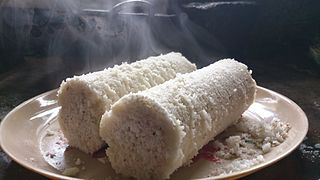
Puttu is a dish native to the Southern Indian state of Kerala, Tamil Nadu, parts of Karnataka, and Sri Lanka. Puttu means "portioned" in Tamil and Malayalam. It is made of steamed cylinders of ground rice layered with coconut shavings, sometimes with a sweet or savory filling on the inside. Puttu is usually a breakfast dish served hot with either sweet side dishes such as palm sugar or banana, or savoury with chana masala, chutney, rasam, or meat curries.
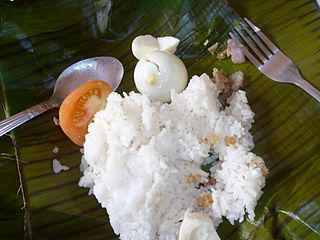
Binalot is a method of wrapping and serving food in the Philippines using banana leaves and alike. The term is derived from the root word balot (wrap) + -in- meaning "wrapped".
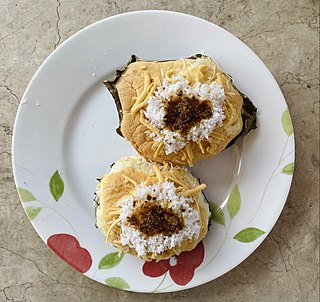
Bibingka commonly refers to a type of baked rice cake from the Philippines that is traditionally cooked in a terracotta oven lined with banana leaves and is usually eaten for breakfast or as merienda especially during the Christmas season.
Janno Ronaldo Ilagan Gibbs is a Filipino singer-songwriter, actor, and comedian in the Philippines. He was a regular host of GMA Network television shows SOP Rules, Nuts Entertainment, Eat Bulaga!, Kakasa Ka Ba Sa Grade 5?, Power of 10, Party Pilipinas and Sunday All Stars.

Puto is a Filipino steamed rice cake, traditionally made from slightly fermented rice dough (galapong). It is eaten as is or as an accompaniment to a number of savoury dishes. Puto is also an umbrella term for various kinds of indigenous steamed cakes, including those made without rice. It is a sub-type of kakanin.

Mamón are traditional Filipino chiffon or sponge cakes, typically baked in distinctive cupcake-like molds. In the Visayas regions, mamón are also known as torta mamón or torta. Variants of mamón include the larger loaf-like version called taisan, the rolled version called pianono, and ladyfingers known as broas. Mamón also has two very different variants that use mostly the same ingredients, the cookie-like mamón tostado and the steamed puto mamón.

Puto seco, also known as puto masa, are Filipino cookies made from ground glutinous rice, cornstarch, sugar, salt, butter, and eggs. They are characteristically white and often shaped into thick disks. They have a dry, powdery texture.

Kue putu or putu bambu is an Indonesian kue. It is made of rice flour called suji and coloured green with pandan leaves, filled with palm sugar, steamed in bamboo tubes, and served with desiccated coconut. This traditional bite-sized snack is commonly found in maritime Southeast Asia, particularly in Java, Indonesia, where it is called putu bumbung. Kue putu is usually sold by street vendors and can be found in traditional markets, along with other kues. Kue putu can also be found in the Netherlands due to its colonial ties with Indonesia.
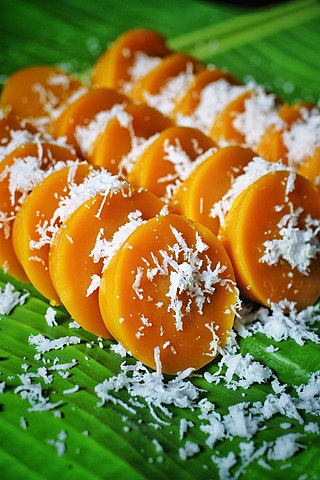
Puto cuchinta or kutsinta is a type of steamed rice cake (puto) found throughout the Philippines. It is made from a mixture of tapioca or rice flour, brown sugar and lye, enhanced with yellow food coloring or annatto extract, and steamed in small ramekins. It bears resemblance to the Burmese mont kywe the and Indonesian and Malaysian kuih kosui.

Biko is a sweet rice cake from the Philippines. It is made of coconut milk, brown sugar, and sticky rice. It is usually topped with latik. It is a type of kalamay dish and is prepared similarly, except the rice grains are not ground into a paste. They are also sometimes packaged and sold as suman.

Filipino American cuisine has been present in America ever since Filipinos moved there, but only recently has the Filipino food become more widely popular. Filipino food has gone through its evolution of adapting other cultures' food practices into their own, or borrowing the food concept into their own.

Salukara is a type of pancake of the Waray people in Eastern Samar, Philippines. It is made with galapong, coconut milk, sugar, and water, the same ingredients to make the cake called bibingka. Traditionally tubâ is used as the leavening agent, giving the pancakes a slightly sour aftertaste, though standard baker's yeast can be substituted. They are cooked in a pan or clay pot traditionally greased with pork lard or lined with banana leaves. They are commonly eaten for breakfast and for merienda.

Puto bumbong is a Filipino purple rice cake steamed in bamboo tubes. It is traditionally sold during the Christmas season. It is a type of puto.
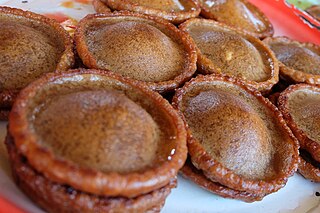
Panyalam or panyam, is a traditional Filipino-Bangsamoro fried rice pancake. It is made with ground glutinous rice, muscovado, and coconut milk mixed into a batter that is deep-fried.
Sayongsong is a traditional Filipino steamed rice cake from Surigao del Norte and other areas of the Caraga Region of northeastern Mindanao, as well as the southeastern Visayas where it is known as sarungsong or alisuso. It is distinctively served in cone-shaped banana leaves. Sayongsong is a type of puto.

Uraró, also known as araró or arrowroot cookies, are Filipino cookies made from arrowroot flour. They have a dry and powdery texture and are usually flower-shaped. They originate from the Tagalog people of southern Luzon, particularly in the provinces of Laguna, Quezon, and Marinduque.














